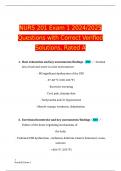Exam (elaborations)
NURS 201 Exam 1 2024/2025 Questions with Correct Verified Solutions, Rated A
- Course
- NURS 201
- Institution
- Rasmussen College
NURS 201 Exam 1 2024/2025 Questions with Correct Verified Solutions, Rated ANURS 201 Exam 1 2024/2025 Questions with Correct Verified Solutions, Rated ANURS 201 Exam 1 2024/2025 Questions with Correct Verified Solutions, Rated ANURS 201 Exam 1 2024/2025 Questions with Correct Verified Solutions, Ra...
[Show more]



